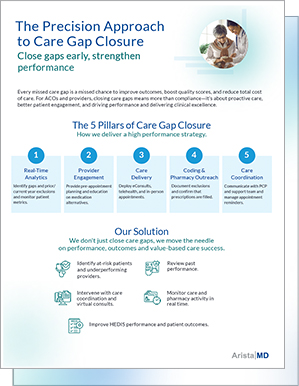Every missed care gap is a missed chance to improve outcomes, boost quality scores, and reduce total cost of care. Our “The Precision Approach to Care Gap Closure” flyer helps educate providers on how we support closing gaps early and strengthening performance through the following:
- The 5 Pillars of Care Gap Closure – Delivering a high-performance strategy
- Care Gap Closure in Action – Choosing the right tool for each gap and patient
- Performance Oversight – The Value of Data
Learn more about how we can transform your care management approach and achieve measurable results for your patients and organization.
Understanding and Anticipating Care Gaps
According to the 2025 quality reporting standards, HEDIS measures evaluate the percentage of patients receiving recommended care within the measurement year. Addressing care gaps supports better patient outcomes, enhances quality performance, and helps manage medical loss ratios (MLR).
However, effective gap closure starts not with today’s data but with yesterday’s performance.
Organizations should first review last year’s results:
Which measures fell short?
Were prescriptions filled—but not refilled?
Were recommended therapies initiated on time?
Were exclusions like ESRD or hospice care correctly documented?
Which provider panels had the highest rates of care gaps?
This retrospective analysis builds the foundation for targeted action. Patients who ended the year with unresolved gaps are more likely to repeat that pattern unless engaged proactively.
Next, teams must identify and predict gaps at the patient level. By analyzing pharmacy claims, EHR data, and care coordination reports, health systems can flag:
Patients are currently missing evidence-based treatments
Those at risk based on prior behavior (e.g., missed refills)
Patients who meet exclusion criteria but are not yet properly coded
Tools like Patient Care Opportunity Reports (PCOR), Gaps in Care Reports, and Practice Assist support early identification of care needs, enabling timely, personalized outreach. Dashboards tracking quality measures and pharmacy adherence further help providers close gaps efficiently, strengthening both outcomes and performance.


